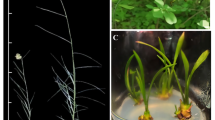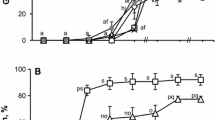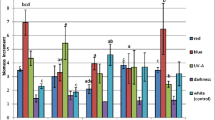Abstract
The growth of Laurencia okamurae and the content of laurinterol and debromolaurinterol were influenced by various factors. Temperature influenced growth raere te with a maximum at 25°C, regardless of daylength. Maturity depended on temperature rather than daylength; the plants grew without maturing at 15°C, while the plants matured within two weeks at 25°C. The plants were able to grow at salinities of 14–50‰ with maximum growth at 26‰. The salinities growth rash;50‰te reduced with decreasing concentration of nitrate below 1.2 × 10-3 M, and of total phosphate below 7.5× 10-8 M. Bromide concentration had no effect on growth, and the plants grew without bromide. Variation in temperature between 15–25°C and daylength produced no obvious change in laurinterol and debromolaurinterol contents. On the other hand, an increase in salinity led to an increase for both. The plants cultured in a completely artificial medium, modified ASP12NTA, showed a marked drop in their content of these metabolites. An increase in concentrations of nitrate, total phosphate or bromide did not restore the content.
Similar content being viewed by others
References
Fenical W (1975) Halogenation in the Rhodophyta. A review. J. Phycol. 11: 245–259.
Kitade Y, Yamazaki S, Saga N (1996) A method for extraction of high molecular weight DNA from the macroalga Porphyra yezoensis (Rhodophyta). J. Phycol. 32: 496–498.
Lobban CS, Harrison PJ (1994) Seaweed Ecology and Physiology. Cambridge, New York, 366 pp.
Nakanishi K, Nishijima M, Nishimura M, Kuwano K, Saga N (1996) Bacteria that induce morphogenesis in Ulva pertusa (Chlorophyta) grown under axenic conditions. J. Phycol. 32: 479–482.
Provasoli L (1963) Growing marine seaweed. Proc. int. Seaweed Symp. 4: 9–17.
Provasoli L (1968) Media and prospects for the cultivation of marine algae. In Watanabe A, Hattori A (eds), Cultures and Collections of Algae, Proc. U.S. – Japan Conf., Hakone, September 1966. Japan. Soc. Plant Physiol., Tokyo: 63–75.
Sims JJ, Donnell MS, Leary JV, Lacy GH (1975) Antimicrobial agents from marine algae. Antimicrobial Agents and Chemotherapy 7: 320–321.
Suzuki M, Kurosawa E (1979) Halogenated and non-halogenated aromatic sesquiterpenes from the red algae Laurencia okamurai Yamada. Bull. chem. Soc. Japan 52: 3352–3354.
Young DN, Howard BM, Fenical W (1980) Subcellular localization of brominated secondary metabolites in the red alga Laurencia snyderae. J. Phycol. 16: 182–185.
Author information
Authors and Affiliations
Rights and permissions
About this article
Cite this article
Kuwano, K., Matsuka, S., Kono, S. et al. Growth and the content of laurinterol and debromolaurinterol in Laurencia okamurae (Ceramiales, Rhodophyta). Journal of Applied Phycology 10, 9–14 (1998). https://doi.org/10.1023/A:1008037706596
Issue Date:
DOI: https://doi.org/10.1023/A:1008037706596




